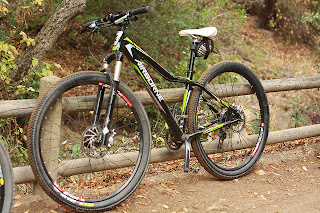As many of you may or may not know, Airborne's World Headquarters is located in Ohio. Winters in Ohio tend to be very cold with snow (usually) on the ground from late December thru early March.
Most of us here are year-round riders and have been riding thru the winters for years. We'd like to share a few tips with you that we've learned to help you get the most from your bike and your winter riding.
TAKING CARE OF THE BIKE
Winter can be rough on a mountain bike, but if you take steps to prep your bike, you'll keep your bike in tip top shape. Some of us use an older bike during the winter to prevent water or salt damage to our "good" bikes, however if you only have one bike its still possible to ride all year round as long as you take care of it. How much prep and maintenance your bike needs depends on how and when you ride your bike.
- Clean and dry your bike regularly during the winter months. Wet conditions like rain, snow or ice can wreck havoc on your bike. Washing, drying and lubing your bike often keeps it clean and rust free. If you have to wash it in a high-pressure carwash, be certain to do it on the low setting (don't pull the trigger all the way).
- Riding in snow requires less psi for better traction. Deflate your winter tires to around 25 to 35 psi. Tires with larger nobs with more space around them are better than small nobs that are close together.
- Wax the outside of your bike's frame with carnuba car wax. This will help keep water, mud and snow from sticking to the frame and it protects the bike's look, and makes cleaning much easier and faster.
- Check your brake pads regularly for wear. Salt, sand and other materials from roads and trails can build up quickly and wear the pads out more quickly. Know that you can go thru a set of pads in the winter months so be prepared to get new pads when you do your spring tune-up.
TAKING CARE OF YOU
Winter can also be rough on you as it is on your bike. However if you heed some of our hard-earned clothing advice it won't be so bad. Below are our tips for riding in temps of 32F and below.
- Layer, layer, layer! Dress in layers. Weare a long sleeve base layer, a long sleeve jersey, and thermal tights to begin with. Then layer from there. Much below 32 you'll need at least a thermal vest, and twenties or below you'll want a full thermal jacket. Wool socks are a must, and if you can fit a thin base-layer sock under them that's even better.
- Invest in a good pair of winter mtb shoes. We like the Sidi Diablo winter boots a lot, but there are a lot of other great winter shoes out there from Lake, Northwave, and 45North. Buy at least one size larger than you normally wear so that you can get two layers of socks on without restricting blood flow to your feet. Restricting the blood flow is the fastest way for your feet to get cold and then go numb (bad!).
- Buy a good pair of winter gloves. Much below 32 degrees we prefer lobster-style gloves, and when it gets into the teens look at full mittens. Pearl Izumi makes some great winter lobster gloves but there are many other good ones out there from Louis Garneau and other companies.
- Cover your head. A nice wool cap that covers your ears and forehead will keep you riding down into the low twenties. Much below that you will want a balaclava that covers your neck and chin. If your normal riding helmet fits you tight with nothing under it, then it may not work for winter. If the helmet has foam pads in it for fitting consider removing those first, but if that doesn't work you may need a larger helmet for the winter.
- Vent, vent, vent! You'll generate more heat than you think while riding, especially when climbing. Be prepared to periodically unzip your outer layer(s) to regulate heat. What you don't want to do is get soaking wet from sweat. Also, remember that cotton is BAD. Do not wear any cotton t-shirts as a base-layer.
- Cover your eyes. If you don't wear protective lenses during the warm months, get used to wearing them in the winter. Covering your eyes from the wind keeps them from tearing up and causing vision issues (and crashes!).
- Hydrate! The bad thing about riding in winter is you often forget to drink while riding and get dehydrated quickly. Buy thermal-insulated bottles, or get a camelback and tuck the bite-valve in your jacket when not using to keep the valve from freezing up.
That's it! Use the simple tips we've given you above to extend your riding season and stay fit and healthy! If you do a good job of it you'll be in great shape when the weather breaks in the spring and you'll be leaving your buddies in the dust on the trail!
